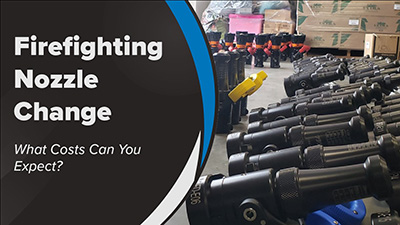What Does a Nozzle Change Cost?
If you are considering a nozzle change, you might be wondering about the costs you can expect. Many people will expect the cost of buying nozzles. Are you thinking about other costs that may be associated with evaluation and implementation of the new nozzles?
In this article we are going to cover five costs you may encounter when replacing your fire nozzles, starting with research costs.
Research Costs
Nozzle research may not seem like a big cost, but it is important to remember the hours your personnel will spend in committee meetings, conducting research, and doing demos. Thorough research is extremely important and shouldn’t be forgotten, so it is time well spent!
If your department decides to send members to visit other departments and view their equipment or setups, this will also add travel costs. You might also send members to training events or trade shows to view products and speak with different companies. Your department may not encounter these costs, though, as you can often find data through published studies or by asking another department to send you their flow and pressure testing results. Essentially, whether you encounter this cost is up to your department and their preferences on gathering data and real-world examples.
To evaluate a new nozzle, your department should have access to a flow meter, pressure gauge, and handheld pitot. Many departments choose to buy these and keep them on hand for future NFPA (National Fire Protection Association) 1962 nozzle testing and evaluation and even hose testing. Other times, departments will borrow these items from another department or the manufacturer supplying a demonstration.
Purchase Cost
The largest cost of your new nozzles will be the purchase cost. This cost can vary depending on the type of nozzles you buy, how many you need, and any customizations or additional options you add.
Most departments expect this to be the largest cost when replacing their nozzles, so it isn’t a surprise to most. One thing that may drive up the cost is whether your department chooses to replace hose at the same time. Either way, you will want to ensure your hose is compatible with the nozzle you choose, especially if you are lowering your operating pressures.
Implementation Costs
When you receive your new nozzles, you will need to take time to swap out old nozzles for new ones. You may also need to write new SOPs (standard operating procedures) or alter existing ones to ensure your new nozzles are included. While this doesn’t directly cost you money, it does use personnel time and pulls them away from other duties.
Disposal of Your Old Nozzles
When it comes to disposal of your old nozzles, there are a lot of options. Some of these will add to your costs and some will lower your overall costs.
You might decide to keep your old nozzles for spare parts if they are compatible with your new ones or if you only did a partial replacement. If your former nozzles are still in good working order and are not too old, you may choose to sell or donate them to another department in need.
Some departments pay a fee to recycle or dispose of the old nozzles in bulk. You can also ask your dealer for trade value, though this is not always an option. For some, the nozzles may be considered government property. In this case, nozzles will need disposed of based on a set policy.
Ongoing Maintenance
Your new nozzles will need regular maintenance like any other piece of equipment. This maintenance is probably quite simple. It may be different than the maintenance you did previously, though, especially if moving from a smooth bore to a combination nozzle.
When considering your ongoing maintenance costs, be sure to understand the warranty coverage of your nozzles and the costs of service outside of warranty coverage. Some manufacturers also offer service and repair classes that enable you to train your own team in basic equipment repair, which may be beneficial.
Conclusion
There are a lot of costs you might see when you evaluate and buy new nozzles. The largest cost is going to be the actual purchase of nozzles, but some of these other factors may provide added cost for your department.
